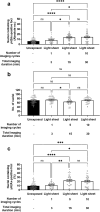Quantifying DNA damage following light sheet and confocal imaging of the mammalian embryo
- PMID: 39237572
- PMCID: PMC11377761
- DOI: 10.1038/s41598-024-71443-x
Quantifying DNA damage following light sheet and confocal imaging of the mammalian embryo
Abstract
Embryo quality assessment by optical imaging is increasing in popularity. Among available optical techniques, light sheet microscopy has emerged as a superior alternative to confocal microscopy due to its geometry, enabling faster image acquisition with reduced photodamage to the sample. However, previous assessments of photodamage induced by imaging may have failed to measure more subtle impacts. In this study, we employed DNA damage as a sensitive indicator of photodamage. We use light sheet microscopy with excitation at a wavelength of 405 nm for imaging embryo autofluorescence and compare its performance to laser scanning confocal microscopy. At an equivalent signal-to-noise ratio for images acquired with both modalities, light sheet microscopy reduced image acquisition time by ten-fold, and did not induce DNA damage when compared to non-imaged embryos. In contrast, imaging with confocal microscopy led to significantly higher levels of DNA damage within embryos and had a higher photobleaching rate. Light sheet imaging is also capable of inducing DNA damage within the embryo but requires multiple cycles of volumetric imaging. Collectively, this study confirms that light sheet microscopy is faster and safer than confocal microscopy for imaging live embryos, indicating its potential as a label-free diagnostic for embryo quality.
© 2024. The Author(s).
Figures







Similar articles
-
Fluorescence microscopy gets faster and clearer: roles of photochemistry and selective illumination.Yale J Biol Med. 2014 Mar 5;87(1):21-32. eCollection 2014 Mar. Yale J Biol Med. 2014. PMID: 24600334 Free PMC article.
-
Optical imaging of cleavage stage bovine embryos using hyperspectral and confocal approaches reveals metabolic differences between on-time and fast-developing embryos.Theriogenology. 2021 Jan 1;159:60-68. doi: 10.1016/j.theriogenology.2020.10.012. Epub 2020 Oct 10. Theriogenology. 2021. PMID: 33113445
-
Imaging adult C. elegans live using light-sheet microscopy.J Microsc. 2021 Mar;281(3):214-223. doi: 10.1111/jmi.12964. Epub 2020 Oct 10. J Microsc. 2021. PMID: 32949409 Free PMC article.
-
Live-cell fluorescence imaging of echinoderm embryos.Methods Cell Biol. 2019;151:379-397. doi: 10.1016/bs.mcb.2018.10.006. Epub 2019 Feb 13. Methods Cell Biol. 2019. PMID: 30948020 Review.
-
Viewing early life without labels: optical approaches for imaging the early embryo†.Biol Reprod. 2024 Jun 12;110(6):1157-1174. doi: 10.1093/biolre/ioae062. Biol Reprod. 2024. PMID: 38647415 Free PMC article. Review.
Cited by
-
Deep learning classification integrating embryo images with associated clinical information from ART cycles.Sci Rep. 2025 May 21;15(1):17585. doi: 10.1038/s41598-025-02076-x. Sci Rep. 2025. PMID: 40399312 Free PMC article.
-
The role of light sheet microscopy for non-invasive imaging of live embryos.Hum Reprod. 2025 Jul 1;40(7):1377-1378. doi: 10.1093/humrep/deaf091. Hum Reprod. 2025. PMID: 40373285 Free PMC article. No abstract available.
References
-
- Adolfsson, E. & Andershed, A. N. Morphology vs morphokinetics: A retrospective comparison of inter-observer and intra-observer agreement between embryologists on blastocysts with known implantation outcome. JBRA Assist. Reprod.22, 228–237. 10.5935/1518-0557.20180042 (2018). 10.5935/1518-0557.20180042 - DOI - PMC - PubMed
MeSH terms
Grants and funding
LinkOut - more resources
Full Text Sources

